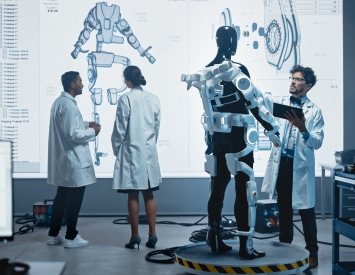Addressing unmet medical challenges through advanced biomedical engineering holds the promise of significant improvements in human health. This article explores five key areas identified by a recent study where innovative engineering approaches could lead to transformative breakthroughs.
Human health could be improved with five cutting-edge biomedical engineering advances could improve human health. The Institute of Electrical and Electronics Engineers (IEEE), along with the IEEE Engineering in Medicine and Biology Society (IEEE EMBS), recently released a comprehensive position paper titled “Grand Challenges at the Interface of Engineering and Medicine.” This paper, published in the IEEE Open Journal of Engineering in Medicine and Biology, outlines crucial avenues for technological and medical advancements.
Dr. Michael Miller, senior author of the paper and director of the Department of Biomedical Engineering at Johns Hopkins University, underscored its significance: “What we’ve accomplished here will serve as a roadmap for groundbreaking research to transform the landscape of medicine in the coming decade.”
The position paper emerged from a collaborative effort involving 50 researchers from 34 universities worldwide. It resulted from a two-day workshop jointly organized by IEEE EMBS, the Department of Biomedical Engineering at Johns Hopkins University, and the Department of Bioengineering at the University of California San Diego.
Paolo Bonato, Ph.D., director of the Motion Analysis Laboratory at Spaulding Rehabilitation, highlighted the paper’s importance: “This manuscript is a unique contribution by 50 key players in the field of biomedical engineering highlighting areas of future technical developments that are expected to enable advanced precision medicine interventions.”
Dr. Metin Akay, founding chair of the Biomedical Engineering Department at the University of Houston, emphasized the collaborative nature of the endeavor: “This paper represents a major milestone in the advancement of biomedical engineering, which could only have been achieved through close collaboration rather than the work of many siloed individuals.”
The 5 Biomedical Engineering Advances to Change it All
The consortium identified five primary medical challenges that could significantly enhance human health if addressed through advanced biomedical engineering. Here’s a breakdown of these innovative advancements:

Bridging Precision Engineering and Precision Medicine
In today’s digital era, the abundance of patient data offers immense potential for personalized healthcare. By harnessing this data to create accurate physiological models, known as “avatars,” tailored patient care, diagnosis, risk prediction, and treatment can be achieved. Wearable sensors and digital twins are instrumental in realizing this vision.
On-Demand Tissue and Organ Engineering
Tissue engineering is on the brink of a transformative phase, where the ability to engineer tissues and organs on demand is becoming a reality. Key advancements in stem cell engineering, gene editing, and organ-on-a-chip technology are crucial to driving this progress, paving the way for personalized predictions and treatments.
Revolutionizing Neuroscience with AI
Artificial Intelligence (AI) holds the promise of revolutionizing neuroscience by analyzing brain function in real-world scenarios. AI-powered advanced brain-interface systems offer noninvasive insights into pathological brain function. Furthermore, brain prosthetics and neural organoids are poised to alleviate the burden of neurological disorders.
Engineering the Immune System
A deeper understanding of the immune system’s mechanisms enables strategic interventions to redesign human cells for therapeutic purposes. Immunotherapy exemplifies this approach, integrating engineering principles with genomic and nanomedicine technologies. Harnessing the immune system holds immense potential for combating diseases like cancer.
Designing and Engineering Genomes
Despite strides in genomics, challenges remain in engineering genomic DNA for therapeutic purposes. Understanding the intricacies of the human genome allows for the creation of innovative solutions to various diseases. Advances in gene delivery methods are critical components of this endeavor.
Diagnosing and Treating Biomedical Engineering Challenges
Despite strides in biomedical engineering, significant hurdles remain in gene delivery methods for in vivo gene engineering (when corrected genes are given directly to the patient). Biomedical engineering plays a pivotal role in addressing this challenge.
“These grand challenges offer unique opportunities that can transform the practice of engineering and medicine,” remarked Dr. Shankar Subramaniam, the task force’s lead author and distinguished professor at the University of California, San Diego.

He comments: ” Innovations in the form of multi-scale sensors and devices, creation of humanoid avatars, and the development of exceptionally realistic predictive models driven by AI can radically change our lifestyles and response to pathologies. Institutions can revolutionize education in biomedical and engineering, training the greatest minds to engage in the most important problem of all times—human health.”
Institutions like the Engineering Institute of Technology (EIT) offer a course in biomedical engineering to boost technicians’ involvement in maintaining existing medical machinery. Through hands-on training and a cutting-edge curriculum, EIT equips students with the expertise to make meaningful contributions to healthcare.
References
Study describes five cutting-edge advances in biomedical engineering
Ground-Breaking Biomedical Engineering Innovations that You Didn’t Know Existed


